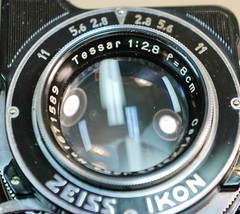Difference between revisions of "Tessar"
m (minor links) |
Danipuntocom (talk | contribs) m (Added link about repairing a Tessar) |
||
| Line 56: | Line 56: | ||
==Sources== | ==Sources== | ||
* Rudolf Kingslake, ''A History of the Photographic Lens'', Academic Press, 1989 | * Rudolf Kingslake, ''A History of the Photographic Lens'', Academic Press, 1989 | ||
| + | |||
| + | == Links == | ||
| + | * [http://oomz.net/tessar/ How to clean or repair a 50mm f2.8 Tessar, by Michel Pollet] | ||
[[Category: Lens]] | [[Category: Lens]] | ||
Revision as of 19:02, 23 June 2010

|
| Cross-section of a 50mm f2.8 Tessar, with front element on the left. (for 35mm, M42 fitting) |
The Tessar is a camera lens designed by Dr. Paul Rudolph, working for the Carl Zeiss Jena company, in 1902. It is normally used as a standard lens, and versions of it have been fitted to many millions of cameras.
The design consists of four elements in three groups; the front element is positive, bi-convex (with the rear almost flat), the central a negative bi-concave and, following an aperture, at the rear is a cemented doublet of plano-concave and a bi-convex elements. Though often referred to as a "modified Cooke triplet", the Tessar is actually a development of Rudolph's 1899 Unar (4 element in 4 groups) lens, itself a development of Rudolph's 1890 Zeiss Anastigmat (4 elements in 2 groups) lens.

|
| Cut-away diagram of a Tessar |

|
| Tessar on Ikonta |
The original design had a maximum aperture of f/6.3, but the developments in design allowed f/2.8 by 1930.
In addition to production by Carl Zeiss, the Tessar name and design (under license) was used in the production of numerous lenses by Bausch & Lomb (Rochester), Ross (London) and Krauss (Paris).
The Tessar design has been widely copied by nearly all major optics companies.
A very partial list includes:
- Agfa Solinar
- Asahi/Pentax Macro-Takumar 50mm f/4
- Bausch & Lomb Tessar (under license)
- Canon 38mm FLP, 50mm f/2.8 and f/3.5 RF lenses, 50mm FL f/3.5
- Dallmeyer Dalmac, Perfac, Serrac
- Ernemann Ernon
- FED/KMZ Industar
- Ilex Paragon
- Kodak Ektar
- Konica Macro-Hexanon AR 55 mm f/3.5
- Krauss-Zeiss Tessar (under license)
- Leitz Elmar
- Mamiya Press lenses - 100mm f/3.5, 127mm f/4.7, 150mm f/5.6
- Meyer Primotar
- Minolta Rokkor TLR
- Minox Minoxar
- Nikon 45mm GN Nikkor, El-Nikkor 50mm f/4
- Olympus in many of their compact cameras including the Trip 35 (40mm f/2.8) and mju series.
- Plaubel Anticomar
- Rodenstock Ysar, Rogonar
- Ross Xtralux
- Ross Tessar (under license)
- Schneider Xenar, Comparon
- Taylor & Hobson Apotal, Ental
- Voigtlander Heliostigmat, Skopar
- Wollensak Raptar
- Yashica Yashinon TLR
Sources
- Rudolf Kingslake, A History of the Photographic Lens, Academic Press, 1989